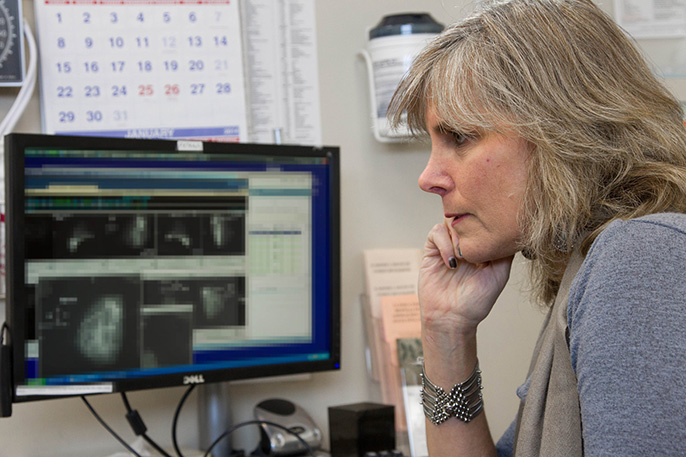
UC San Francisco's Laura van 't Veer devised the MammaPrint test, which predicts the risk of cancer recurrence by measuring the expression of a suite of 70 genes.
The following content originally appeared on universityofcalifornia.edu. View the original post.
Scientists across the University of California system are taking aim at breast cancer. Along with developing better detection methods, researchers are making advances in imaging techniques and tapping into advances in genetics and immunology to develop more refined approaches to treatment.
Improved imaging
UC Davis researcher John Boone is taking another route to catch cancer. Boone has been awarded a $2.9 million grant from the National Cancer Institute to further develop and research computed tomography (CT) to detect breast cancer. CT imaging, also known as CAT scanning, provides cross-sectional images of the body that contain more detailed information than a standard 2-D screening mammogram.
Boone is a pioneer in breast CT, working with a team of scientists and physicians for more than 15 years to develop the technology.
“We hope to move the standard-of-care to true 3-D breast imaging in order to improve care and increase survival in women with breast cancer, and importantly to also reduce over-treatment of women with benign findings,” Boone said.

UC San Francisco surgeon Laura Esserman leads the Athena Breast Health Network.
Credit: Susan Merrell/UC San Francisco
Precision screening
UC also is studying whether a personalized approach to breast cancer screening is safe and effective.
A five-year study, backed by the Patient-Centered Outcomes Research Institute, will test a more targeted approach to breast cancer screening. Those at higher risk will be screened more often and those at lower risk screened less often. Annual screening will be weighed against a personalized schedule of screening based on each woman’s individual risk.
The WISDOM study will involve approximately 100,000 women 40 to 80 years old via the Athena Breast Health Network, a collaboration of the five UC medical centers to drive innovation in breast cancer prevention, screening and treatment.
“We’re going to generate a risk (assessment) for women and that will trigger when to start screening, when to stop screening and how often to screen,” said UC San Francisco surgeon Laura Esserman, who leads Athena. “Over time we’ll learn who is at risk for breast cancer and who is at risk for different interventions. If this works, this could be a good paradigm to approach any disease.”
Choosing the best options
Once breast cancer is diagnosed, it’s important for patients to receive the appropriate treatment.
Doctors have raised concerns about the rise in mastectomies for breast cancer, where the entire breast is removed. While that may be the safest course for some patients, breast-saving procedures may be as effective for others, especially for women with early-stage cancers in one breast.
“It’s fear and lack of education,” Alice Police, a UC Irvine breast surgeon told the Orange County Register. “I just had a patient who came in … saying, ‘I want a bilateral (double mastectomy). I’m going to do everything I can to beat this cancer.’ It took me an hour to explain to her that it might hurt her.”
Early-stage breast cancer patients whose tumors carry genetic markers associated with a low risk of disease recurrence may not need chemotherapy, according to a new study that employed a test devised by UCSF researcher Laura van ’t Veer.
Using a genetic test known as MammaPrint, van ’t Veer and her colleagues were able to predict the risk of cancer recurrence by measuring the expression of a suite of 70 genes.
“For the first time, a prospective, randomized trial shows that the active biology of breast cancer in an individual, as assessed by the MammaPrint test, can assist in making a well-informed choice to undergo chemotherapy treatment or not,” said van ’t Veer.